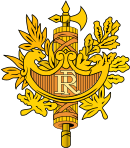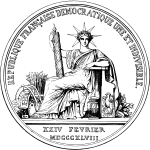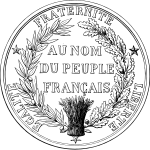National emblem of France
| State symbol of France | |
|---|---|

|
|
| Versions | |
 Official state symbol (mainly used from 1953 to 1995) |
|
| Details | |
| Introduced | 1912 and 1953 |
| Heraldic shield | Bundle of Lictors |
| Orders and decorations | Grand Masters Chain of the Legion of Honor (1953 version only) |
The national emblem of France has been used since 1953. An official national coat of arms has not existed since 1912.
description
The official national symbol of France was determined in 1953 as follows: It is a blue oval on which there is a golden bundle of lictors ( fascis ). This is tied with golden ribbons and the golden ax inside it is turned to the left . A golden ribbon is placed on it, which shows France's motto Liberté, Egalité, Fraternité ( freedom, equality, brotherhood ). The bundle of lictors is surrounded by oak and laurel branches . The blue oval is bordered by the Grand Master's Chain ( Collane ) of the Legion of Honor . This form was first used in 1905 on the occasion of the state visit of Alfonso XIII. used in Paris.
However, state authorities now rarely use this official state symbol. Instead, an unofficial emblem is used, which only shows the bundle of lictors with oak and laurel branches and a plaque with the inscription RF ( République française ). It can also be seen on passports.
In addition, a logo for authorities was designed, which shows a stylized form of the emblem. In 2018, the Lorraine cross was added there (see here ). Another shows the French flag with the silhouette of Marianne .
Great seal
The Great Seal of the French Republic was introduced in 1848 and is still affixed to particularly important official documents (such as constitutional amendments) to this day. It is kept by the keeper of the seal of France - an office that still exists today and is now carried out by the Minister of Justice. The seal shows on the front a seated Libertas (similar to the depiction of the Statue of Liberty ) with a fascis , a tiller and a Gallic cock . At her feet is an urn with the inscription "SU" (for Suffrage Universel , French for universal suffrage ). Next to her are symbols of art, architecture, education and agriculture. The motto " RÉPUBLIQUE FRANÇAISE, DÉMOCRATIQUE, UNE ET INDIVISIBLE" means "French Republic, democratic, united and indivisible". On the back of the seal is “ AU NOM DU PEUPLE FRANÇAIS” (in the name of the French people), framed by oak leaves and the national motto “ LIBERTÉ, ÉGALITÉ, FRATERNITÉ ” .
history
After the French Revolution, all emblems related to the monarchy were removed. As a result, France is the only European state that does not have a national coat of arms. The current state symbol was introduced in 1905 and supplemented in 1953 by the Grand Master's Chain of the Legion of Honor.
| coat of arms | Remarks | Period |
|---|---|---|

|
Medieval coat of arms, royal escutcheon in blue studded with golden lilies.
Between 1305 and 1328, Louis X. for a time also kept a two-part shield with the Navarre coat of arms . |
before 1376 |

|
Early modern coat of arms, royal escutcheon in blue with three golden fleurs de lys (stylized lilies) on blue shields. | 1376-1469 |

|
With the establishment of the Ordre de Saint-Michel , its collar was added to the coat of arms, followed by the Order of the Holy Spirit in 1578 . In the meantime, Franz I had inserted a new, closed crown in 1515. | 1469-1589 |

|
The coat of arms of the Ancien Régime as it was used until the Revolution, since the accession of Henry IV , King of Navarre and King of France . | 1589-1792 |

|
Alternative royal coat of arms | 1790-1792 |

|
Emblem of the First French Republic | 1791-1804 |

|
The coat of arms of the first French republic under Napoleon Bonaparte with a golden eagle in Roman style, holding thunderbolts and lightning bolts in his claws, in blue heraldic shields. | 1799-1804 |

|
The coat of arms of the first empire under Napoleon Bonaparte . | 1804-1814 |

|
With the restoration , the Bourbon house came with Louis XVIII. and Charles X again to power. | 1814-1830 |

|
At the beginning of the July monarchy , Louis-Philippe I established the coat of arms and seal of France by order of August 13, 1830 : “À l'avenir le sceau de l'État représentera les armes d'Orléans surmontées de la couronne fermée, avec le scepter et la main de justice en sautoir, et des drapeaux tricolores derrière l'écusson. " | 1830-1831 |

|
Coat of arms of the July Monarchy until the February Revolution of 1848 . | 1831-1848 |

|
Coat of arms of the Second French Republic under Louis-Napoleon Bonaparte (until today the Great Seal of France). | 1848-1852 |

|
The coat of arms of the Second Empire under Napoleon III. based on the model of the first empire. | 1852-1870 |

|
National emblem for diplomatic missions of the Third Republic | 1880-1898 |

|
State symbol as it was newly created for the Third Republic. | 1898-1905 |

|
Revised state symbol of the Third and later the Fourth Republic | 1905-1953 |

|
State symbol of the Vichy regime | 1940-1944 |

|
Emblem of Philippe Pétain , the head of state of Vichy France (here in the variant with the regime's motto: “Work, family, fatherland”). Although the Franziska was only a personal emblem, it was used by the regime on official documents such as a coat of arms. | 1940-1944 |

|
State symbol of the Fifth Republic | 1953 – today
( de jure ) |
See also
- Flags and coats of arms of the regions of France
- Flags and coats of arms of the French overseas territories
- Coat of arms of the departments of France
literature
- Karl-Heinz Hesmer: Flags and coats of arms of the world. History and symbolism of the flags and coats of arms of all states . Bertelsmann Lexikon Verlag, Gütersloh 1992, ISBN 3-570-01082-1 .



